Uber Eats: In-Depth Analysis of Requirements and Functionality Report
VerifiedAdded on 2023/06/03
|6
|994
|213
Report
AI Summary
This report provides a comprehensive analysis of Uber Eats, the food delivery application launched by Uber. It outlines the application's purpose, which is to facilitate online food ordering, and discusses its scope for improvement, particularly in expanding its services to more cities and countries. The report defines Uber Eats as a sub-service of Uber, highlighting its use of the same drivers for passenger transport and food delivery. It identifies constraints such as the lack of a dedicated app, high delivery times, and minimum delivery charges. Assumptions include opportunities for service expansion and potential partnerships with restaurants. The report details the application's functional requirements, including platform support for iOS and Android, seamless UX/UI, reliance on third-party software, communication via Google Maps APIs, and databases using MySQL and MongoDB. Non-functional requirements such as high reliability, performance, and security are also discussed. The document concludes with a list of references.
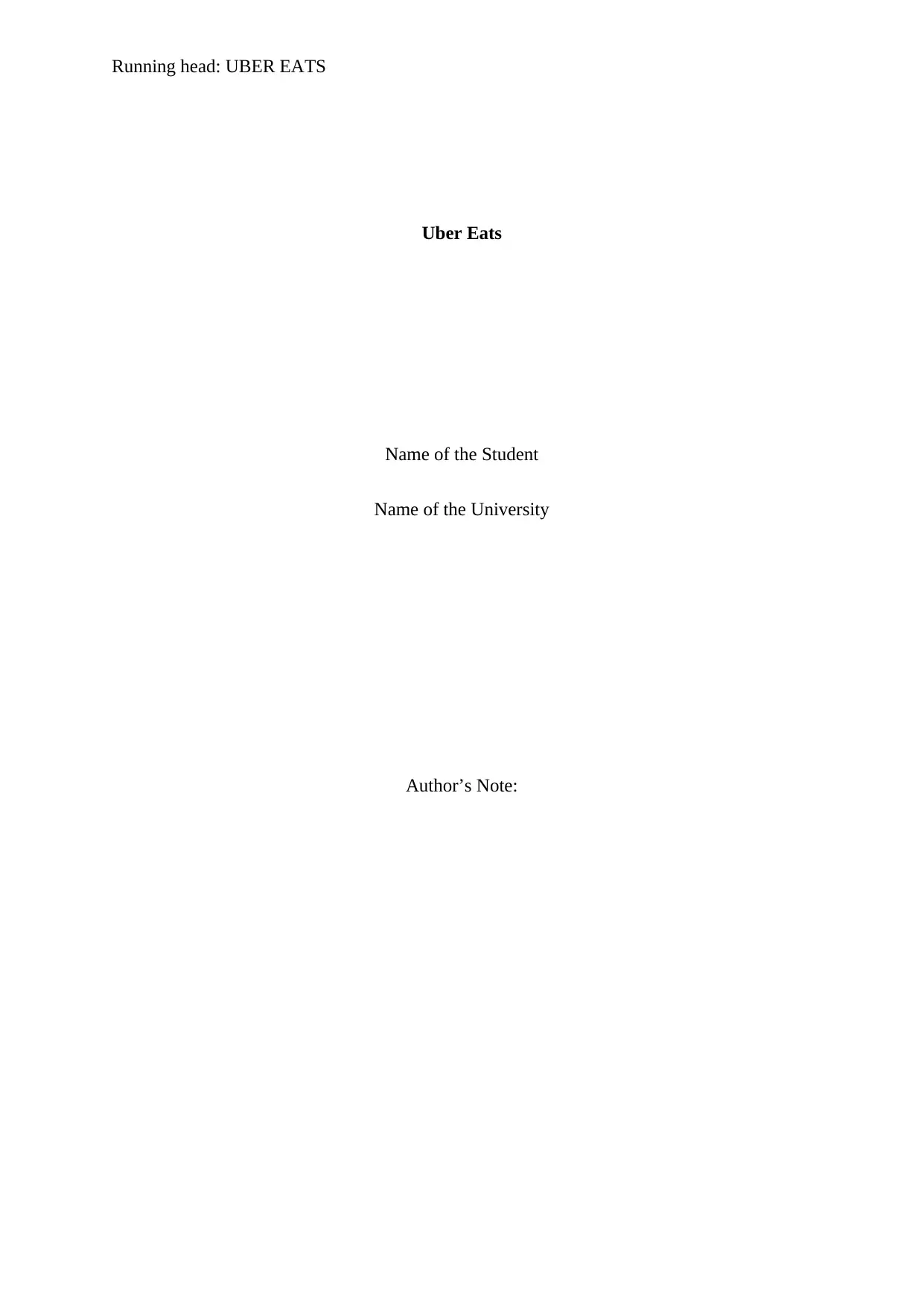
Running head: UBER EATS
Uber Eats
Name of the Student
Name of the University
Author’s Note:
Uber Eats
Name of the Student
Name of the University
Author’s Note:
Paraphrase This Document
Need a fresh take? Get an instant paraphrase of this document with our AI Paraphraser

1
UBER EATS
Table of Contents
1. Introduction............................................................................................................................2
2. Purpose...................................................................................................................................2
3. Scope......................................................................................................................................2
4. Definitions..............................................................................................................................2
5. Constraints..............................................................................................................................3
6. Assumptions...........................................................................................................................3
7. Requirements..........................................................................................................................3
8. Functional Requirements.......................................................................................................3
9. Non-Functional Requirements...............................................................................................4
References..................................................................................................................................5
UBER EATS
Table of Contents
1. Introduction............................................................................................................................2
2. Purpose...................................................................................................................................2
3. Scope......................................................................................................................................2
4. Definitions..............................................................................................................................2
5. Constraints..............................................................................................................................3
6. Assumptions...........................................................................................................................3
7. Requirements..........................................................................................................................3
8. Functional Requirements.......................................................................................................3
9. Non-Functional Requirements...............................................................................................4
References..................................................................................................................................5
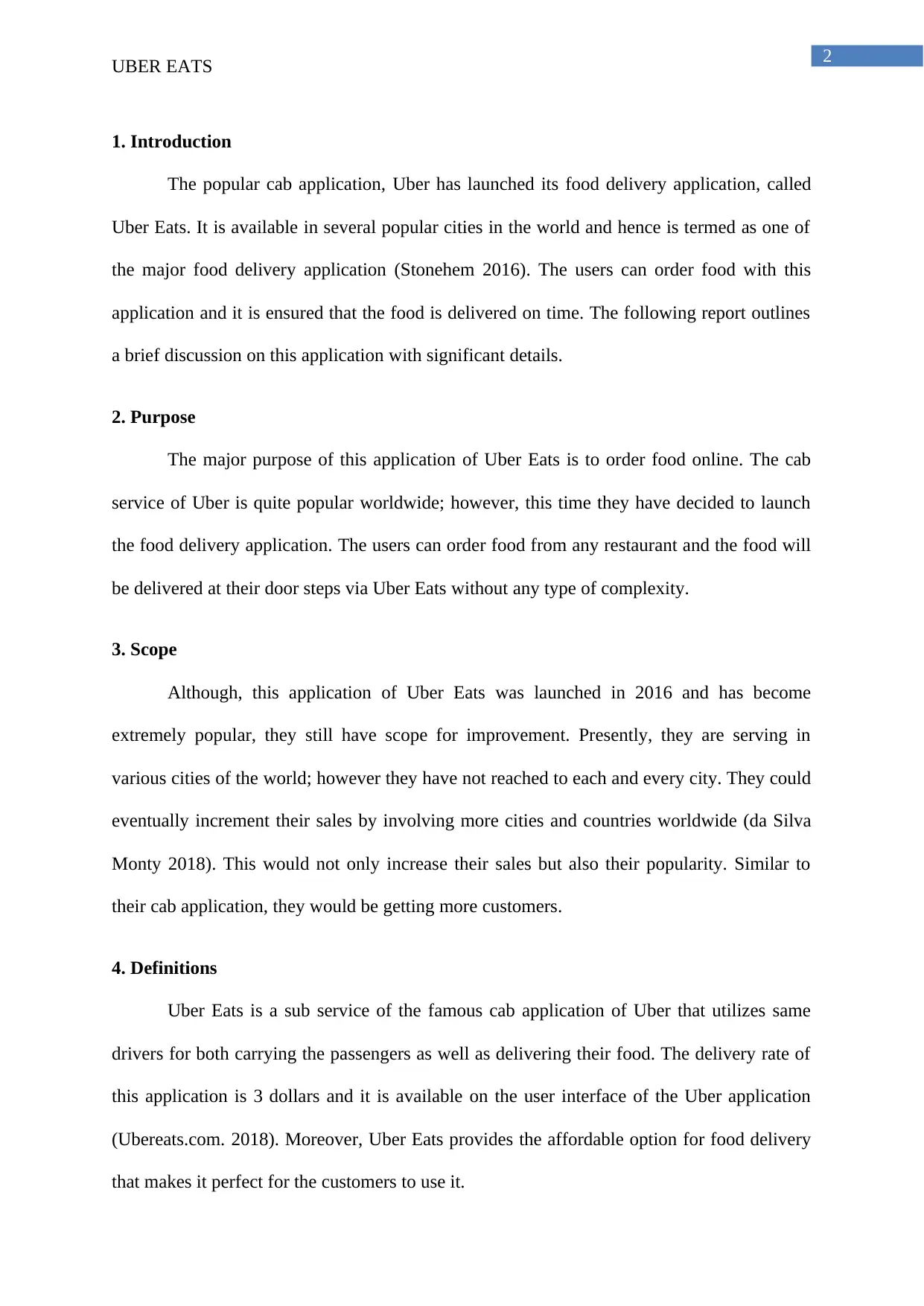
2
UBER EATS
1. Introduction
The popular cab application, Uber has launched its food delivery application, called
Uber Eats. It is available in several popular cities in the world and hence is termed as one of
the major food delivery application (Stonehem 2016). The users can order food with this
application and it is ensured that the food is delivered on time. The following report outlines
a brief discussion on this application with significant details.
2. Purpose
The major purpose of this application of Uber Eats is to order food online. The cab
service of Uber is quite popular worldwide; however, this time they have decided to launch
the food delivery application. The users can order food from any restaurant and the food will
be delivered at their door steps via Uber Eats without any type of complexity.
3. Scope
Although, this application of Uber Eats was launched in 2016 and has become
extremely popular, they still have scope for improvement. Presently, they are serving in
various cities of the world; however they have not reached to each and every city. They could
eventually increment their sales by involving more cities and countries worldwide (da Silva
Monty 2018). This would not only increase their sales but also their popularity. Similar to
their cab application, they would be getting more customers.
4. Definitions
Uber Eats is a sub service of the famous cab application of Uber that utilizes same
drivers for both carrying the passengers as well as delivering their food. The delivery rate of
this application is 3 dollars and it is available on the user interface of the Uber application
(Ubereats.com. 2018). Moreover, Uber Eats provides the affordable option for food delivery
that makes it perfect for the customers to use it.
UBER EATS
1. Introduction
The popular cab application, Uber has launched its food delivery application, called
Uber Eats. It is available in several popular cities in the world and hence is termed as one of
the major food delivery application (Stonehem 2016). The users can order food with this
application and it is ensured that the food is delivered on time. The following report outlines
a brief discussion on this application with significant details.
2. Purpose
The major purpose of this application of Uber Eats is to order food online. The cab
service of Uber is quite popular worldwide; however, this time they have decided to launch
the food delivery application. The users can order food from any restaurant and the food will
be delivered at their door steps via Uber Eats without any type of complexity.
3. Scope
Although, this application of Uber Eats was launched in 2016 and has become
extremely popular, they still have scope for improvement. Presently, they are serving in
various cities of the world; however they have not reached to each and every city. They could
eventually increment their sales by involving more cities and countries worldwide (da Silva
Monty 2018). This would not only increase their sales but also their popularity. Similar to
their cab application, they would be getting more customers.
4. Definitions
Uber Eats is a sub service of the famous cab application of Uber that utilizes same
drivers for both carrying the passengers as well as delivering their food. The delivery rate of
this application is 3 dollars and it is available on the user interface of the Uber application
(Ubereats.com. 2018). Moreover, Uber Eats provides the affordable option for food delivery
that makes it perfect for the customers to use it.
⊘ This is a preview!⊘
Do you want full access?
Subscribe today to unlock all pages.

Trusted by 1+ million students worldwide
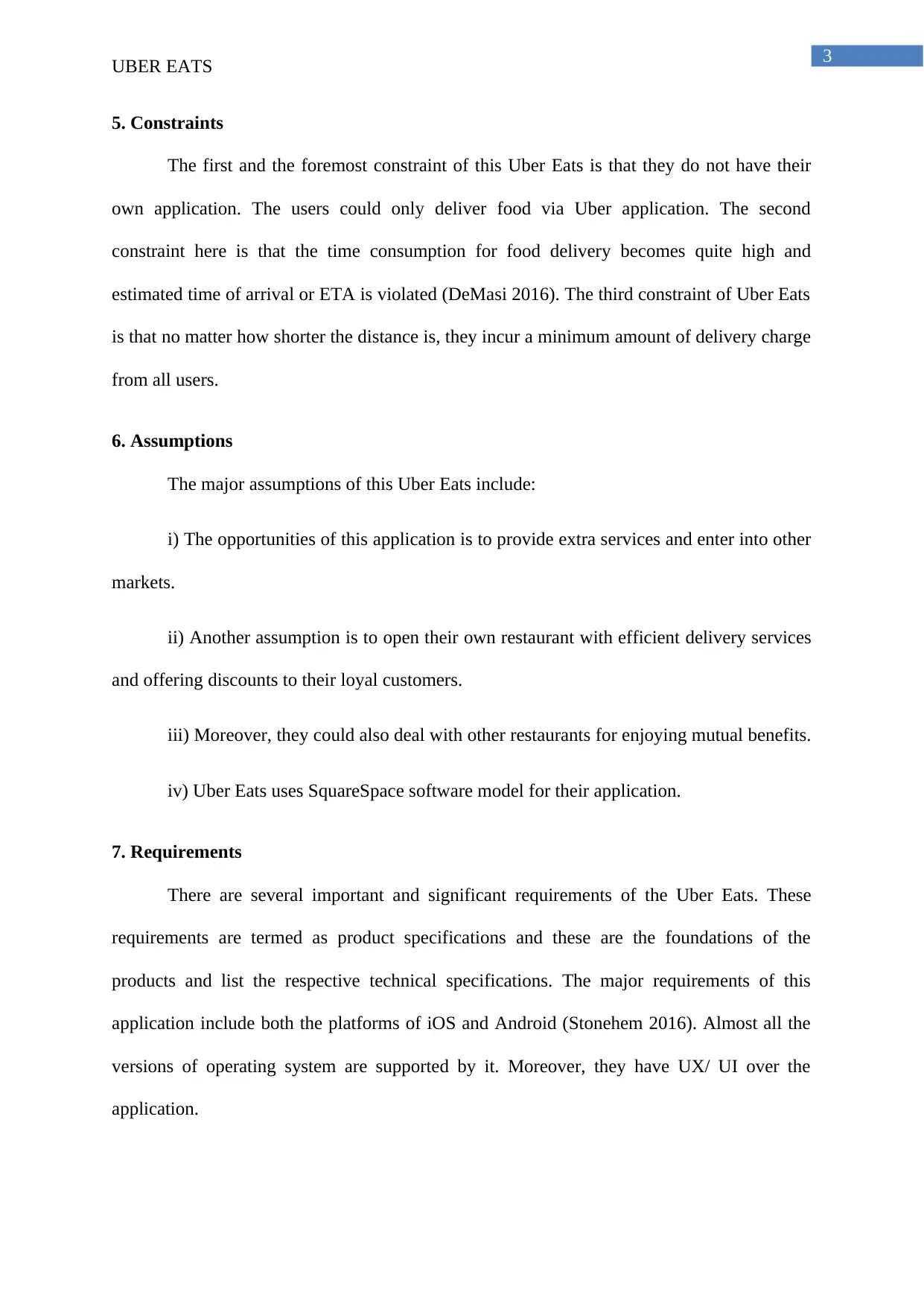
3
UBER EATS
5. Constraints
The first and the foremost constraint of this Uber Eats is that they do not have their
own application. The users could only deliver food via Uber application. The second
constraint here is that the time consumption for food delivery becomes quite high and
estimated time of arrival or ETA is violated (DeMasi 2016). The third constraint of Uber Eats
is that no matter how shorter the distance is, they incur a minimum amount of delivery charge
from all users.
6. Assumptions
The major assumptions of this Uber Eats include:
i) The opportunities of this application is to provide extra services and enter into other
markets.
ii) Another assumption is to open their own restaurant with efficient delivery services
and offering discounts to their loyal customers.
iii) Moreover, they could also deal with other restaurants for enjoying mutual benefits.
iv) Uber Eats uses SquareSpace software model for their application.
7. Requirements
There are several important and significant requirements of the Uber Eats. These
requirements are termed as product specifications and these are the foundations of the
products and list the respective technical specifications. The major requirements of this
application include both the platforms of iOS and Android (Stonehem 2016). Almost all the
versions of operating system are supported by it. Moreover, they have UX/ UI over the
application.
UBER EATS
5. Constraints
The first and the foremost constraint of this Uber Eats is that they do not have their
own application. The users could only deliver food via Uber application. The second
constraint here is that the time consumption for food delivery becomes quite high and
estimated time of arrival or ETA is violated (DeMasi 2016). The third constraint of Uber Eats
is that no matter how shorter the distance is, they incur a minimum amount of delivery charge
from all users.
6. Assumptions
The major assumptions of this Uber Eats include:
i) The opportunities of this application is to provide extra services and enter into other
markets.
ii) Another assumption is to open their own restaurant with efficient delivery services
and offering discounts to their loyal customers.
iii) Moreover, they could also deal with other restaurants for enjoying mutual benefits.
iv) Uber Eats uses SquareSpace software model for their application.
7. Requirements
There are several important and significant requirements of the Uber Eats. These
requirements are termed as product specifications and these are the foundations of the
products and list the respective technical specifications. The major requirements of this
application include both the platforms of iOS and Android (Stonehem 2016). Almost all the
versions of operating system are supported by it. Moreover, they have UX/ UI over the
application.
Paraphrase This Document
Need a fresh take? Get an instant paraphrase of this document with our AI Paraphraser
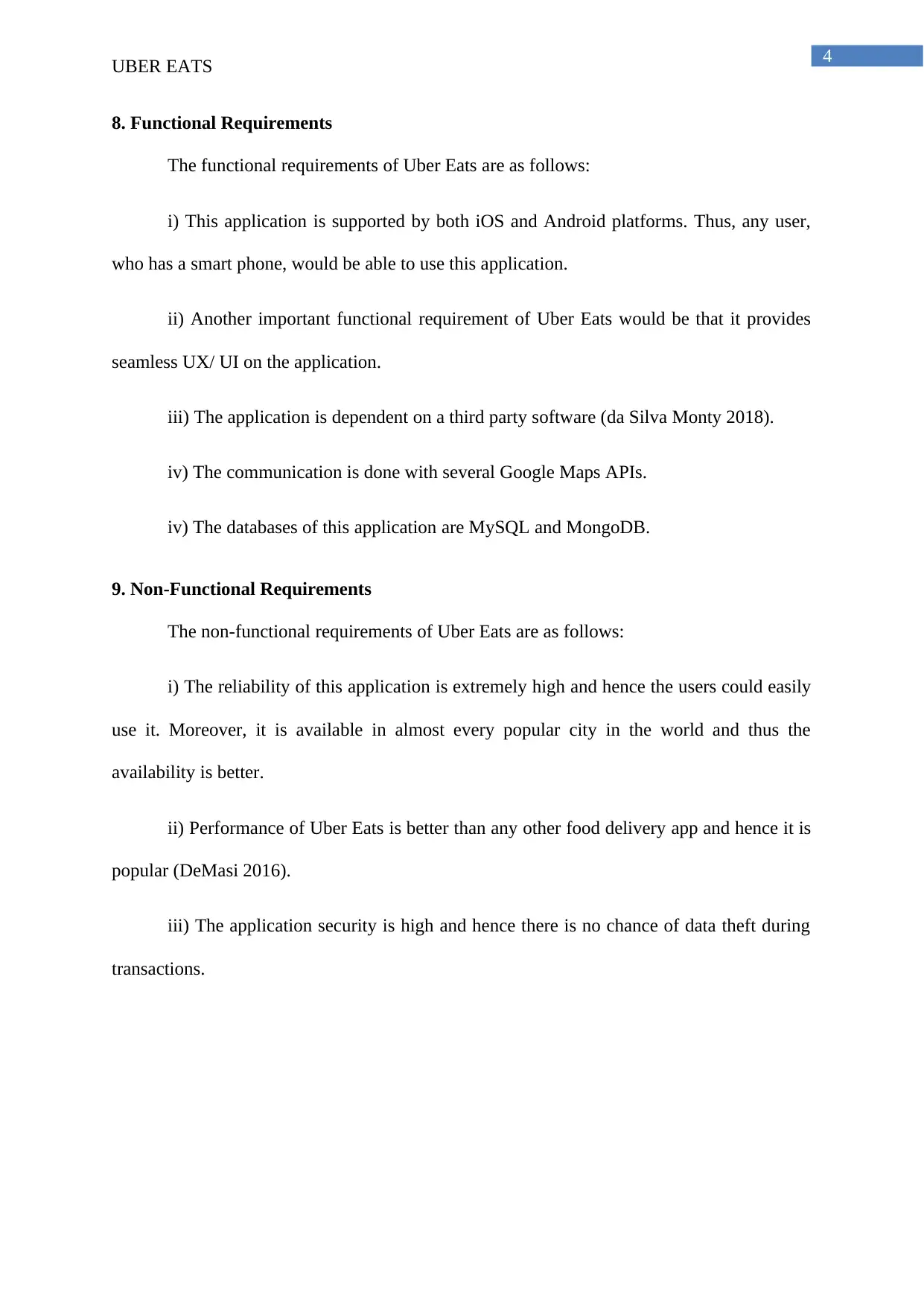
4
UBER EATS
8. Functional Requirements
The functional requirements of Uber Eats are as follows:
i) This application is supported by both iOS and Android platforms. Thus, any user,
who has a smart phone, would be able to use this application.
ii) Another important functional requirement of Uber Eats would be that it provides
seamless UX/ UI on the application.
iii) The application is dependent on a third party software (da Silva Monty 2018).
iv) The communication is done with several Google Maps APIs.
iv) The databases of this application are MySQL and MongoDB.
9. Non-Functional Requirements
The non-functional requirements of Uber Eats are as follows:
i) The reliability of this application is extremely high and hence the users could easily
use it. Moreover, it is available in almost every popular city in the world and thus the
availability is better.
ii) Performance of Uber Eats is better than any other food delivery app and hence it is
popular (DeMasi 2016).
iii) The application security is high and hence there is no chance of data theft during
transactions.
UBER EATS
8. Functional Requirements
The functional requirements of Uber Eats are as follows:
i) This application is supported by both iOS and Android platforms. Thus, any user,
who has a smart phone, would be able to use this application.
ii) Another important functional requirement of Uber Eats would be that it provides
seamless UX/ UI on the application.
iii) The application is dependent on a third party software (da Silva Monty 2018).
iv) The communication is done with several Google Maps APIs.
iv) The databases of this application are MySQL and MongoDB.
9. Non-Functional Requirements
The non-functional requirements of Uber Eats are as follows:
i) The reliability of this application is extremely high and hence the users could easily
use it. Moreover, it is available in almost every popular city in the world and thus the
availability is better.
ii) Performance of Uber Eats is better than any other food delivery app and hence it is
popular (DeMasi 2016).
iii) The application security is high and hence there is no chance of data theft during
transactions.
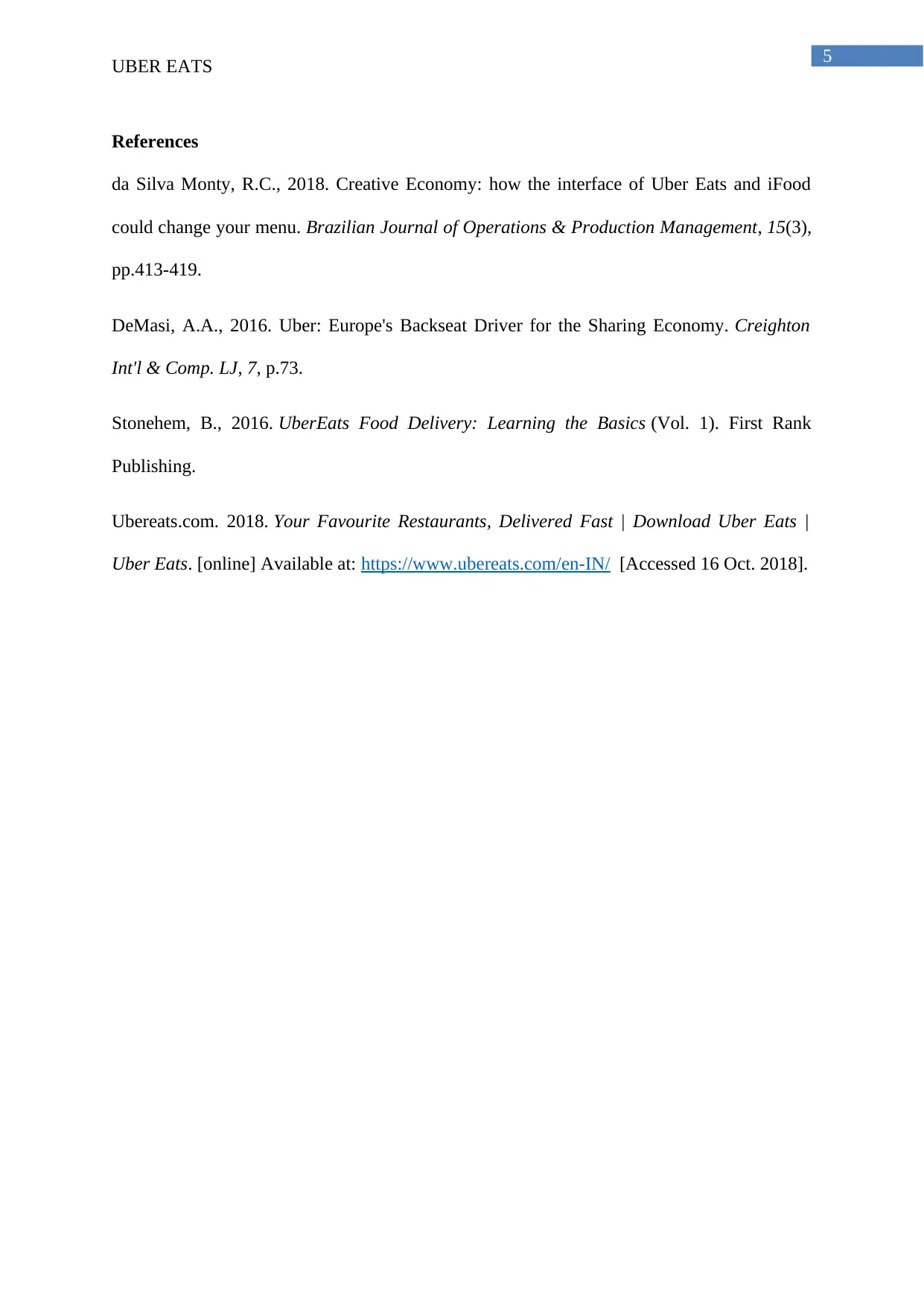
5
UBER EATS
References
da Silva Monty, R.C., 2018. Creative Economy: how the interface of Uber Eats and iFood
could change your menu. Brazilian Journal of Operations & Production Management, 15(3),
pp.413-419.
DeMasi, A.A., 2016. Uber: Europe's Backseat Driver for the Sharing Economy. Creighton
Int'l & Comp. LJ, 7, p.73.
Stonehem, B., 2016. UberEats Food Delivery: Learning the Basics (Vol. 1). First Rank
Publishing.
Ubereats.com. 2018. Your Favourite Restaurants, Delivered Fast | Download Uber Eats |
Uber Eats. [online] Available at: https://www.ubereats.com/en-IN/ [Accessed 16 Oct. 2018].
UBER EATS
References
da Silva Monty, R.C., 2018. Creative Economy: how the interface of Uber Eats and iFood
could change your menu. Brazilian Journal of Operations & Production Management, 15(3),
pp.413-419.
DeMasi, A.A., 2016. Uber: Europe's Backseat Driver for the Sharing Economy. Creighton
Int'l & Comp. LJ, 7, p.73.
Stonehem, B., 2016. UberEats Food Delivery: Learning the Basics (Vol. 1). First Rank
Publishing.
Ubereats.com. 2018. Your Favourite Restaurants, Delivered Fast | Download Uber Eats |
Uber Eats. [online] Available at: https://www.ubereats.com/en-IN/ [Accessed 16 Oct. 2018].
⊘ This is a preview!⊘
Do you want full access?
Subscribe today to unlock all pages.

Trusted by 1+ million students worldwide
1 out of 6
Related Documents
Your All-in-One AI-Powered Toolkit for Academic Success.
+13062052269
info@desklib.com
Available 24*7 on WhatsApp / Email
![[object Object]](/_next/static/media/star-bottom.7253800d.svg)
Unlock your academic potential
Copyright © 2020–2026 A2Z Services. All Rights Reserved. Developed and managed by ZUCOL.





